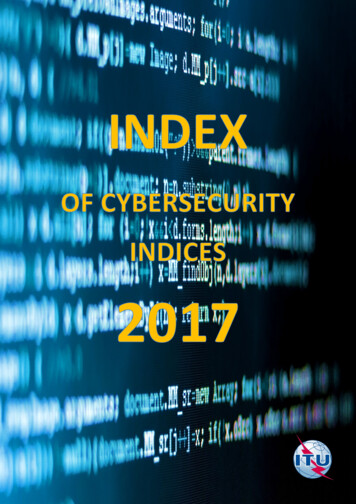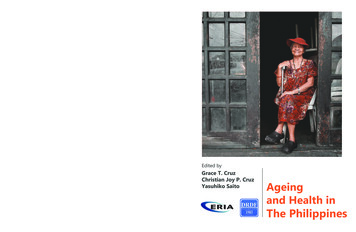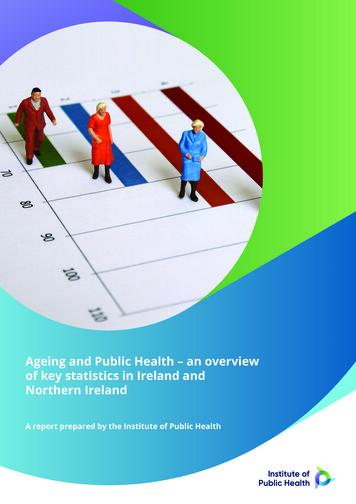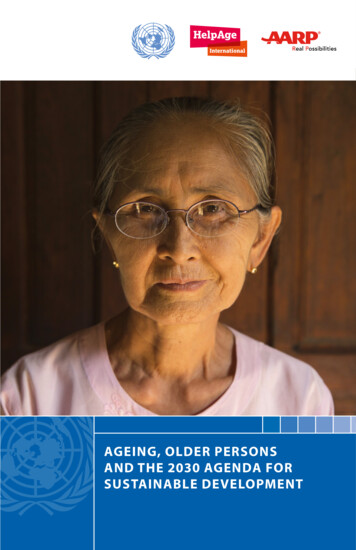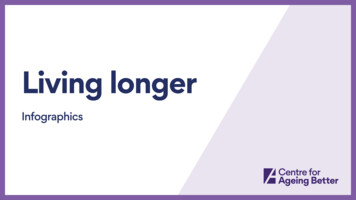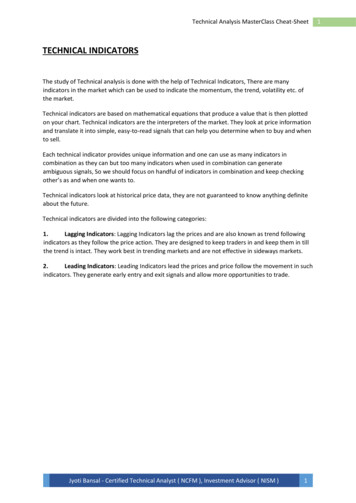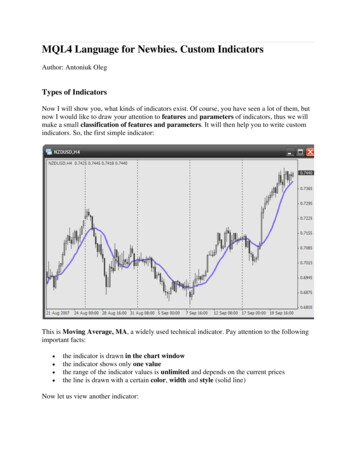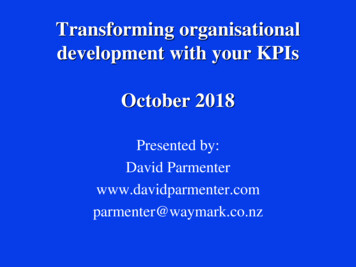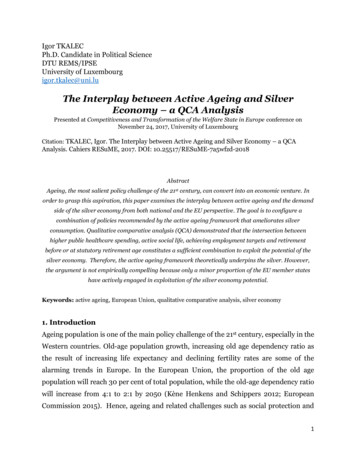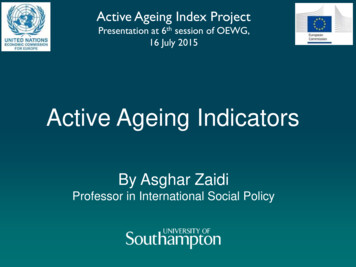
Transcription
Active Ageing Index ProjectPresentation at 6th session of OEWG,16 July 2015Active Ageing IndicatorsBy Asghar ZaidiProfessor in International Social Policy
Active Ageing IndexAcknowledgementsThe work presented here was undertaken within theframework of the joint management project of the UNECEand the European Commission’s DG EMPL. Theresearch work for the Active Ageing Index is currentlyundertaken at University of Southampton, with the help ofadvice received from the AAI Expert Group.The material presented and its interpretation do not implythe expression of any opinion whatsoever on the part ofthe funders.2
Active Ageing IndexOverview1. Active ageing as a policy approach2. Introducing Active Ageing Index (AAI)3. Five key findings from the latest AAI Report(for 28 EU countries)4. Active Ageing Index and its relevance to thework of OEWG on Ageing3
Two key messagesActive Ageing Index1. Active ageing is a right for older persons,beneficial not just for older persons but also fortheir families and communities and societies inwhich they live;2. The work of the AAI shows that a fullerrealisation of AA remains an aspiration, even inthe most developed welfare states of the EU; Convention on Rights of Older Persons will helppromote active and healthy ageing and in theprocess turn longevity into an asset, leadingcountries to a more sustainable path of socialand economic development.4
Active Ageing IndexImportant caveats1. Active ageing indicators do not capture fullythe rights of older people – additional rightsspecific indicators are essential.2. The Active Ageing Index (AAI) if analysedtaking into account information on rights canoffer a framework (methodology) for thebaseline assessment and monitoring of rightsof older people.5
Active Ageing Index1Active ageing as a policyapproach6
Active ageing as a policy approach If population ageing is to become a positive experience,then the increase in life expectancy must beaccompanied by active and healthy years added to life. The underlying idea is that active and engaged peoplecontribute to their own health, wellbeing and autonomyas well as to the welfare of the society in which they live. AA include paid work as well as unpaid activities,influenced by policies and programmes of thegovernments and by our own behaviour (e.g. healthyliving)
Recent Policy emphasis on active ageing(at the EUR level)I. Designation of 2012 as the European Year for ActiveAgeing and Solidarity between Generations.II. European Innovation Partnership on Active andHealthy Ageing (EIP-AHA) – setting out the target toincrease the average healthy lifespan of Europeansby 2 years by 2020;III. Vienna Ministerial Declaration for the 2nd 5-yearreview of MIPAA: ‘Ensuring a society for all ages:Promoting quality of life and active ageing’(September 2012)
Policy emphasis globally (in the UN Commission forSocial Development programme 2013-2015)The focus is placed on ‘empowerment’, defined as“the process of enhancing the capacity of individuals orgroups to make choices and to transform those choicesinto desired actions and outcomes”.The same UN Report goes on to say: ‘empowerment has to be promoted through people’seffective engagement in economic, social and political life,and the provision of adequate resources and assets’.
WHO (2002) Active Ageing Framework‘Active ageing is the process of optimizing opportunitiesfor health, participation and security in order to enhancequality of life as people age’ .ILC-Brazil (2015) Active Ageing Policy Framework a rights-based framework, extending the 2002framework by an additional pillar: lifelong learning.emphasising the importance of four types of capitals: Health capital; Knowledge capital; Social capital andFinancial capital
Active Ageing Index2IntroducingActive Ageing Index11
Key features of the AAI projectI. Initiated during 2012, to contribute to activities ofEY2012 and MIPAA for its 10th anniversary;II. Advised by the AAI Expert Group, comprisingdiverse group of international experts andstakeholders (including AGE Platform Europe)III. The purpose is to develop a comparative,empirical instrument on ageing that: highlights the contributions of older peopleand identify the potential that goes untapped! evaluates and monitor progress, and engagepolicy makers for mutual learning.12
Analytical framework22 indicators, 4 domains13
Selection of AA indicators Focus on human capital of older people, by promotingpositive paradigms of ageing (rather then viewing olderpeople as dependent)ageing and development Indicators reflect the rights as well as responsibilities ofolder people (for example, the first domain presents a rightto work, as well as a responsibility for longer careers) In many instances, low values of AAI indicators will reflectdenial of rights of older people- Age discriminationlow employment- Healthcare servicesindependent living-Social protectionSecure living14
Critical observations about the AAIAAI indicators focus on outcomes rather than processes:Legal instrumentsImplementationOutcomes Indicators chosen in consultation with AAI ExpertGroup, including older people reps (Age PlatformEurope). AAI not intending to measure the well-being of olderpeople, but the contributions of older people.see also Global AgeWatch Index whichmeasures the QOL / well-being of older people, byHelpAge International15
Datasets used for the AAI indicators19 Indicators from four prime datasets EU Labour Force Survey European Quality of Life Survey EU Survey of Income and Living Conditions European Social Survey, mainly wave2 indicators ‘RLE at 55’ and ‘HLE at 55’Joint Action: European Health & Life ExpectancyInformation system (JA EHLEIS)‘Use of ICT by older persons aged 55-74’ (4th domain) Eurostat ICT survey16
Active Ageing Index3Five Key findingsActive Ageing Index 2014Analytical ReportApril 201517
Key message 1: Affluent EU States in the Northernand Western Europe have had greater successAlso, stabilityobserved in therelative position ofEU countries overthe period 20082012
Key message 2: Top-ranked countries not at top ofeach domain and indicator, falling short of goalposts71%66%52%90%84%
Key message 3:AAI scores formen are higherthan women,especially whereemploymentand incomesare involved
Key message 4:Active ageing hasbeen increasing inthe EU, despiteeconomic crisis andausterity measuresOn average, an increaseof nearly 2 points in theEU, while an increase ofnearly 3 points or morein nine EU countries(during 2008-2012).
Key message 5:A push towardsactive ageing doesnot imply aworsening of olderpeople’s quality oflife, and it bringsreal benefits to theeconomyNo cause-and-effectdirection implied!
Active Ageing Index4Active Ageing Index and itsrelevance to OEWG on ageing23
Active Ageing Index1. The active ageing strategies empower older peoplehelping them fulfil their full potential and improve theirquality of life this is also one key purpose of the new Conventionon the Rights of Older Persons!2. The AAI framework helps identify specific prioritiesfor each country to identify where the potential of olderpeople is not realised, and how much? The AAI framework (if analysed taking into accountinformation on rights) can be used to highlightwhere a legislation or its implementation for therights of older people remain unfulfilled!24
Active Ageing Index3. The AAI framework provides a detailed cross-countrycomparisons of domains and individual AA indicatorsand help identify successful and innovative policyinstruments. The AAI framework (if analysed with rights-specificindicators) offers us a methodology that can beused to identify good practices in achieving rights ofolder people!25
Active Ageing IndexThank youAsghar.Zaidi@soton.ac.uk@zaidiaFor more information, see: UNECE/ European Commission (2015)“Active Ageing Index 2014: Analytical Report”, Report preparedby Asghar Zaidi of Centre for Research on Ageing, University ofSouthampton (UK) and David Stanton, under contract with UnitedNations Economic Commission for Europe (Geneva), co-funded by theEuropean Commission’s Directorate General for Employment, SocialAffairs and Inclusion (Brussels).26
3. The AAI framework provides a detailed cross-country comparisons of domains and individual AA indicators and help identify successful and innovative policy instruments. The AAI framework (if analysed with rights-specific indicators) offers us a methodology that can be used to identify good practices in achieving rights of older people!

